
List of Alaska mammals
Encyclopedia
This is a list of Alaska mammals. It includes all mammal
s currently found in Alaska
, whether resident or as migrant
s. With 112 mammal species, Alaska ranks 12th of the 50 U.S. states in mammalian diversity.
This article presents the common and scientific names for each species, along more information about the animal. Where the species is unique to Alaska, this article presents a brief overview of the species. Where the species is not unique to Alaska, this article gives information about the habits and distribution that are characteristic of animals occurring in the state. The range maps that accompany the descriptions vary in their precision according to the sources on which they are based. Readers are advised to click on the maps and examine the source information for more information on the species' ranges.
Bat
Bats are not abundant in Alaska, and are generally found only in Southeast Alaska, some of Southcentral Alaska, and in the Interior as far north as the Yukon River.
Felines
Canines
Bear
Weasels and related animals (Mustelidae
Pikas, hares, and rabbits (Lagomorpha
Rodent
Mammal
Mammals are members of a class of air-breathing vertebrate animals characterised by the possession of endothermy, hair, three middle ear bones, and mammary glands functional in mothers with young...
s currently found in Alaska
Alaska
Alaska is the largest state in the United States by area. It is situated in the northwest extremity of the North American continent, with Canada to the east, the Arctic Ocean to the north, and the Pacific Ocean to the west and south, with Russia further west across the Bering Strait...
, whether resident or as migrant
Animal migration
Animal migration is the relatively long-distance movement of individuals, usually on a seasonal basis. It is a ubiquitous phenomenon, found in all major animal groups, including birds, mammals, fish, reptiles, amphibians, insects, and crustaceans. The trigger for the migration may be local...
s. With 112 mammal species, Alaska ranks 12th of the 50 U.S. states in mammalian diversity.
This article presents the common and scientific names for each species, along more information about the animal. Where the species is unique to Alaska, this article presents a brief overview of the species. Where the species is not unique to Alaska, this article gives information about the habits and distribution that are characteristic of animals occurring in the state. The range maps that accompany the descriptions vary in their precision according to the sources on which they are based. Readers are advised to click on the maps and examine the source information for more information on the species' ranges.
Shrews
Alaska shrews have not been studied as much as most of its animals, so many particulars of their distribution, breeding cycles, and population remain unknown. Currently, ten species of shrews have been identified in Alaska, but debate remains over their identity and genetic relationships. All of Alaska's shrew species look alike to lay observers, but experts differentiate them based on their ranges and skull structure. Shrews live throughout the state, even on isolated islands, in habitats from temperate rain forests of the Southeast to Arctic tundra. They generally eat insects, spiders, and other small invertebrates, though they may also eat other meat and plants. Their predators in Alaska include weasels, marten, fox, domestic cats, other shrews, and owls. Shrews may be helpful in agricultural areas by eating insects, but elsewhere they may be pests by eating household meat left uncovered. None of Alaska's shrew populations is threatened, with the possible exception of the Pribilof Island shrew.| Species | More information | Range |
|---|---|---|
| Sorex alaskanus |
Glacier Bay water shrews are known from Glacier Bay National Park and Preserve Glacier Bay National Park and Preserve Glacier Bay National Park is a national park in Alaska. The area around Glacier Bay in southeastern Alaska was first proclaimed a U.S. National Monument on February 25, 1925. It was changed to Glacier Bay National Park and Preserve on Dec. 2, 1980 by the Alaska National Interest Lands Conservation... in southeast Alaska. |
 |
| Common shrew Sorex cinereus 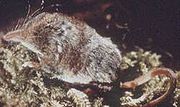 |
The common shrew is one of the two most widespread species of shrew in Alaska (the other being the dusky shrew). It is found from the Brooks Range Brooks Range The Brooks Range is a mountain range in far northern North America. It stretches from west to east across northern Alaska and into Canada's Yukon Territory, a total distance of about 1100 km . The mountains top out at over 2,700 m . The range is believed to be approximately 126 million years old... to Southeast Alaska. |
 |
| Pygmy shrew Sorex hoyi Image |
The pygmy shrew is found throughout most of the state except the North Slope and the southeast. | |
| Pribilof Island shrew Pribilof Island Shrew The Pribilof Island Shrew is a species of mammal in the family Soricidae. It is found only on Alaska's Pribilof Islands.-Further reading:* http://aknhp.uaa.alaska.edu/zoology/pdfs/mammals/Priblof%20Shrew.pdf... Sorex hydrodromus Image |
The Pribilof Island shrew is found only on the Pribilof Islands Pribilof Islands The Pribilof Islands are a group of four volcanic islands off the coast of mainland Alaska, in the Bering Sea, about north of Unalaska and 200 miles southwest of Cape Newenham. The Siberia coast is roughly northwest... . http://aknhp.uaa.alaska.edu/zoology/pdfs/mammals/Priblof%20Shrew.pdf |
 |
| St. Lawrence Island shrew Sorex jacksoni |
The St. Lawrence Island shrew is found only on St. Lawrence Island St. Lawrence Island St. Lawrence Island is located west of mainland Alaska in the Bering Sea, just south of the Bering Strait, at about 63°30' North 173°20' West. The village of Gambell is located on the northwest cape, from the Chukchi Peninsula in the Russian Far East. The island is part of Alaska, but closer to... .http://www.uaf.edu/museum/mammal/AK_Mammals/Shrews/Jacksoni/jacksoni.html |
 |
| Dusky shrew Montane Shrew The Montane Shrew is a species of mammal in the Soricidae family. It is found in Alaska, western Canada, the western United States and Mexico.... Sorex monticolus Image |
The dusky shrew is one of the two most widespread species of shrew in Alaska (the other being the common shrew). It is found from the Brooks Range Brooks Range The Brooks Range is a mountain range in far northern North America. It stretches from west to east across northern Alaska and into Canada's Yukon Territory, a total distance of about 1100 km . The mountains top out at over 2,700 m . The range is believed to be approximately 126 million years old... to Southeast Alaska. |
 |
| Water shrew American Water Shrew The American Water Shrew or Northern Water Shrew, is a large North American shrew found in aquatic habitats. Some sources include the Glacier Bay Water Shrew, S. alaskanus, within this species.... Sorex palustris 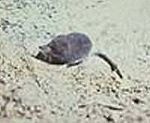 |
The water shrew is found from Southcentral and Southeast Alaska to the Alaska Range Alaska Range The Alaska Range is a relatively narrow, 650-km-long mountain range in the southcentral region of the U.S. state of Alaska, from Lake Clark at its southwest end to the White River in Canada's Yukon Territory in the southeast... in the north. |
|
| Tundra shrew Tundra Shrew The Tundra Shrew is a small shrew found in Alaska, the northern Yukon Territory, the MacKenzie Delta region of the Northwest Territories, extreme northwestern British Columbia and eastern Russia... Sorex tundrensis Image |
Tundra shrews are found throughout most of the state except the southeast. | |
| Barrenground shrew Sorex ugyunak Image |
Barrenground shrews are found on the North Slope. |  |
| Tiny shrew Tiny shrew The tiny shrew is a species of mammal in the Soricidae family. It is a recently identified species known only from a single specimen found at Galena, Alaska.-External links:*... Sorex yukonicus Image |
The tiny shrew appears to be widespread but uncommon in Alaska. |  |
BatBatBats are mammals of the order Chiroptera "hand" and pteron "wing") whose forelimbs form webbed wings, making them the only mammals naturally capable of true and sustained flight. By contrast, other mammals said to fly, such as flying squirrels, gliding possums, and colugos, glide rather than fly,...
s
Bats are not abundant in Alaska, and are generally found only in Southeast Alaska, some of Southcentral Alaska, and in the Interior as far north as the Yukon River.| Species | More information | Range |
|---|---|---|
| Big brown bat Big brown bat The Big Brown Bat is larger in size than comparative species of bats, from about 4 to 5 inches in body length, with a 11-13 inch wingspan and weighing 1/2 to 5/8 ounce. The fur is moderately long, and shiny brown... Eptesicus fuscus 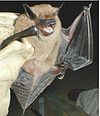 |
Only one big brown bat has ever been confirmed in Alaska. It is the largest bat in Alaska, weighing on average 14g (0.5 oz). | |
| California myotis California Myotis The California Myotis is a species of vesper bat in the Vespertilionidae family.It is found in British Columbia in Canada, Guatemala, Mexico, and in the western United States, including California.... Myotis californicus  |
As with other myotis species in Alaska, the California myotis often roosts in abandoned buildings and old mines; they may also be found roosting alone in trees or rock crevices. California bats have been observed hibernating in Southeast Alaska. |  |
| Keen's myotis Keen's Myotis Keen's Myotis is a species of vesper bat in the Vespertilionidae family.It is found in British Columbia in Canada and in Washington and Alaska in the United States. It is named after the Rev... Myotis keenii Image |
As with other myotis species in Alaska, Keen's myotis often roosts in abandoned buildings and old mines; they may also be found roosting alone in trees or rock crevices. It is suspected that it hibernates in Southeast Alaska. |  |
| Little brown bat Little brown bat The little brown bat is a species of the genus Myotis , one of the most common bats of North America... Myotis lucifugus  |
The little brown bat is the most common and widespread bat in Alaska. As with other myotis species in Alaska, little brown bats often often roost in abandoned buildings and old mines; they may also be found roosting alone in trees or rock crevices. Little brown bats have been observed hibernating in Southeast Alaska and Kodiak Island. |  |
| Long-legged myotis Long-legged Myotis The Long-Legged Myotis is a species of vesper bat in the Vespertilionidae family.It can be found in Alberta and British Columbia in Canada, Mexico, and the western United States.... Myotis volans  |
As with other myotis species in Alaska, the long-legged myotix often roosts in abandoned buildings and old mines; they may also be found roosting alone in trees or rock crevices. It is suspected that it hibernates in Southeast Alaska. |  |
| Silver-haired bat Silver-Haired Bat The Silver-haired Bat is a species of vesper bat in the family Vespertilionidae and the only member of the genus Lasionycteris.- Habitat :...  |
After the big brown bat, the silver-haired bats is the largest bat in Alaska. It is only found in Southeast Alaska, and only during winter. It roosts alone in trees. |  |
FelinesFélinesFélines may refer to the following places in France:* Félines, Ardèche, a commune in the department of Ardèche* Félines, Haute-Loire, a commune in the department of Hérault* Félines-Minervois, a commune in the department of Hérault...
| Species | More information | Range map |
|---|---|---|
| Lynx Lynx canadensis  |
http://www.adfg.state.ak.us/pubs/notebook/furbear/lynx.php |  |
| Mountain lion Puma concolor  |
It is unlikely that there is a breeding population of mountain lions in Alaska, but periodic sightings indicate that some mountain lions venture into the state. Generally the state receives two or three reports of mountain lion sightings per year. Reports have come from as far northwest as Homer Homer, Alaska Homer is a city located in Kenai Peninsula Borough in the U.S. state of Alaska. According to 2005 Census Bureau estimates, the population was 5,364. One of Homer's nicknames is "the cosmic hamlet by the sea"; another is "the end of the road"... , but the most credible reports come from the Southeast, which is relatively near an established population of mountain lions in British Columbia. Populations of mountain lions have been increasing in the American West and in Canada, and biologists have speculated that within fifty years Alaska could have a breeding population of its own.http://www.wildlifenews.alaska.gov/index.cfm?adfg=wildlife_news.view_article&articles_id=26&issue_id=11 |
 |
CaninesCanidaeCanidae is the biological family of carnivorous and omnivorous mammals that includes wolves, foxes, jackals, coyotes, and domestic dogs. A member of this family is called a canid . The Canidae family is divided into two tribes: Canini and Vulpini...
| Species | More information | Range |
|---|---|---|
| Arctic fox Arctic fox The arctic fox , also known as the white fox, polar fox or snow fox, is a small fox native to Arctic regions of the Northern Hemisphere and is common throughout the Arctic tundra biome. The Greek word alopex, means a fox and Vulpes is the Latin version... 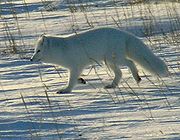 |
Arctic foxes are found in treeless coastal areas in the Aleutian Islands and on the state's west and north coasts. Two color morphs occur in the state: white-morph foxes are white in the winter and brown in the summer, while blue-morph foxes are charcoal-colored in summer and a somewhat lighter gray in winter. During the summer, Arctic foxes feed mainly on small animals, but during the winter foxes often venture onto sea ice to eat seal carcasses left by polar bears. Arctic foxes are sometimes trapped for fur; the fur trade is important to many coastal Native villages, though demand for Arctic fox fur has decreased in recent years.http://www.adfg.state.ak.us/pubs/notebook/furbear/arcfox.php |  |
| Red fox Red Fox The red fox is the largest of the true foxes, as well as being the most geographically spread member of the Carnivora, being distributed across the entire northern hemisphere from the Arctic Circle to North Africa, Central America, and the steppes of Asia... Vulpes vulpes  |
Red foxes are found throughout Alaska, except for the Western Aleutians, some islands in Southeast Alaska, and Prince William Sound. It is an introduced animal on many of the state's islands due to turn-of-the-century fox farming. Red foxes, which are most common south of the Arctic tundra, prefer low marshes, hilly areas, and broken country. Where the red fox's range overlaps with that of the Arctic fox, the red fox dominates. In Alaska, most red foxes are of the characteristic red color phase, but other color phases—which comprise up to 2% of foxes in certain northern areas—include "cross", silver, and black. Predators of red foxes include wolves, lynx, coyotes, wolverines, men (primarily as trappers), and perhaps bears.http://www.adfg.state.ak.us/pubs/notebook/furbear/redfox.php |  |
| Coyote Coyote The coyote , also known as the American jackal or the prairie wolf, is a species of canine found throughout North and Central America, ranging from Panama in the south, north through Mexico, the United States and Canada... Canis latrans  |
Coyotes have only been seen in Alaska since the early 20th century; they were originally reported in Southeast Alaska, but since have expanded across the state. The state's coyote population peaked in the 1940s and has declined in many areas since. Coyotes are most common in the Kenai Peninsula, the Mat-Su Valley, and the Copper River Valley and are rare north of the Yukon River. In Alaska, coyotes' diets consist primarily of snowshoe hares, rodents, and carrion; predators of the young include great horned owls, bald eagles, and golden eagles; adults are preyed upon by wolves, bears and cougars. The state offered bounties for killing coyotes in the early 20th century (as did other states); the bounty program ended in 1969, and today a small number of coyotes are trapped in Alaska each year. Because coyotes are very secretive, they are rarely seen by Alaska residents.http://www.adfg.state.ak.us/pubs/notebook/furbear/coyote.php | |
| Gray wolf Gray Wolf The gray wolf , also known as the wolf, is the largest extant wild member of the Canidae family... Canis lupus 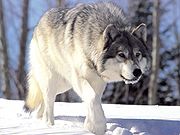 |
There are two subspecies Subspecies Subspecies in biological classification, is either a taxonomic rank subordinate to species, ora taxonomic unit in that rank . A subspecies cannot be recognized in isolation: a species will either be recognized as having no subspecies at all or two or more, never just one... of wolves in Alaska; wolves in the southeast are darker and smaller than those in northern regions. Wolves are found on the mainland of Alaska, Unimak Island, and on most major islands in the southeast. There is approximately one wolf per 25 square miles (64.7 km²) in Alaska. In recent years, efforts to control wolf population through aerial hunting have been a source of controversy in the state. |
 |
| Domestic dog Canis lupus familiaris  |
The dog is the very first domesticated animal to reach to Alaska and probably North America around 20,000 to 40,000 years ago from either the Bering Strait or many other ways Models of migration to the New World There have been several models for the human settlement of the Americas proposed by various academic communities. The question of how, when and why humans first entered the Americas is of intense interest to archaeologists and anthropologists, and has been a subject of heated debate for centuries... . There are some dogs native to Alaska like malamutes, huskies Alaskan Husky The Alaskan husky is not a breed of dog rather it is a type or a category. It falls short of being a breed in that there is no preferred type of and no restriction as to ancestry; it is defined only by its purpose, which is that of a highly efficient sled dog... , and Klee Kais. Dogs were brought by Europe Europe Europe is, by convention, one of the world's seven continents. Comprising the westernmost peninsula of Eurasia, Europe is generally 'divided' from Asia to its east by the watershed divides of the Ural and Caucasus Mountains, the Ural River, the Caspian and Black Seas, and the waterways connecting... ans such as Labradors Labrador Retriever The Labrador Retriever is one of several kinds of retriever, a type of gun dog. A breed characteristic is webbed paws for swimming, useful for the breed's original purpose of retrieving fishing nets. The Labrador is the most popular breed of dog by registered ownership in Canada, the United... , bulldog Bulldog Bulldog is the name for a breed of dog commonly referred to as the English Bulldog. Other Bulldog breeds include the American Bulldog, Olde English Bulldogge and the French Bulldog. The Bulldog is a muscular heavy dog with a wrinkled face and a distinctive pushed-in nose... s, Saint Bernard St. Bernard (dog) The St. Bernard is a breed of very large working dog from the Italian and Swiss Alps, originally bred for rescue. The breed has become famous through tales of alpine rescues, as well as for its large size.-Appearance:The St. Bernard is a large dog... s, and German Shepherds German Shepherd Dog The German Shepherd Dog , also known as an Alsatian or just the German Shepherd, is a breed of large-sized dog that originated in Germany. The German Shepherd is a relatively new breed of dog, with its origin dating to 1899. As part of the Herding Group, the German Shepherd is a working dog... during the Klondike Gold Rush Klondike Gold Rush The Klondike Gold Rush, also called the Yukon Gold Rush, the Alaska Gold Rush and the Last Great Gold Rush, was an attempt by an estimated 100,000 people to travel to the Klondike region the Yukon in north-western Canada between 1897 and 1899 in the hope of successfully prospecting for gold... where people were starting to import dogs from outside of Alaska. Many of these new dogs can't be put outside in Alaska's bug-stinging summers and icy cold winters. |
BearBearBears are mammals of the family Ursidae. Bears are classified as caniforms, or doglike carnivorans, with the pinnipeds being their closest living relatives. Although there are only eight living species of bear, they are widespread, appearing in a wide variety of habitats throughout the Northern...
s
| Species | More information | Range |
|---|---|---|
| Black bear American black bear The American black bear is a medium-sized bear native to North America. It is the continent's smallest and most common bear species. Black bears are omnivores, with their diets varying greatly depending on season and location. They typically live in largely forested areas, but do leave forests in...  |
Black bears, which are much smaller than the state's brown bears, are found in larger numbers on the mainland of Alaska, but are not found on the islands off of the Gulf of Alaska Gulf of Alaska The Gulf of Alaska is an arm of the Pacific Ocean defined by the curve of the southern coast of Alaska, stretching from the Alaska Peninsula and Kodiak Island in the west to the Alexander Archipelago in the east, where Glacier Bay and the Inside Passage are found.The entire shoreline of the Gulf is... and the Seward Peninsula Seward Peninsula The Seward Peninsula is a large peninsula on the western coast of the U.S. state of Alaska. It projects about into the Bering Sea between Norton Sound, the Bering Strait, the Chukchi Sea, and Kotzebue Sound, just below the Arctic Circle... . Black bears have been seen in Alaska in a few different shades of colors such as black, brown, cinnamon, and even a rare blue shade. They are widely scattered over Alaska, and pose more of a problem to humans because they come in close contact with them on a regular basis. They are considered a nuisance because they frequently stroll through local towns, camps, backyards, and streets because of their curiosity and easy food sources such as garbage. Black bears didn't live in Alaska until the end of the last ice age. |
 |
| Brown bear Brown Bear The brown bear is a large bear distributed across much of northern Eurasia and North America. It can weigh from and its largest subspecies, the Kodiak Bear, rivals the polar bear as the largest member of the bear family and as the largest land-based predator.There are several recognized... Ursus arctos  |
Alaska contains about 98% of the U.S. brown bear Brown Bear The brown bear is a large bear distributed across much of northern Eurasia and North America. It can weigh from and its largest subspecies, the Kodiak Bear, rivals the polar bear as the largest member of the bear family and as the largest land-based predator.There are several recognized... population and 70% of the total North American population. Brown bears can be found throughout the state, with the exclusion of some outlying islands. Most brown bears in Alaska are grizzly bear Grizzly Bear The grizzly bear , also known as the silvertip bear, the grizzly, or the North American brown bear, is a subspecies of brown bear that generally lives in the uplands of western North America... s (the subspecies Subspecies Subspecies in biological classification, is either a taxonomic rank subordinate to species, ora taxonomic unit in that rank . A subspecies cannot be recognized in isolation: a species will either be recognized as having no subspecies at all or two or more, never just one... of brown bear found throughout North America North America North America is a continent wholly within the Northern Hemisphere and almost wholly within the Western Hemisphere. It is also considered a northern subcontinent of the Americas... ), but Kodiak Island Kodiak Island Kodiak Island is a large island on the south coast of the U.S. state of Alaska, separated from the Alaska mainland by the Shelikof Strait. The largest island in the Kodiak Archipelago, Kodiak Island is the second largest island in the United States and the 80th largest island in the world, with an... is home to Kodiak bear Kodiak Bear The Kodiak bear , also known as the Kodiak brown bear or the Alaskan grizzly bear or American brown bear, occupies the islands of the Kodiak Archipelago in South-Western Alaska. Its name in the Alutiiq language is Taquka-aq. It is the largest subspecies of brown bear.- Taxonomy :Taxonomist C.H... s, another subspecies of brown bear that is the largest of all the Brown Bears and second only to the Polar Bear in size. The density of brown bear populations in Alaska varies according to the availability of food, and in some places is as high as one bear per square mile. More information... |
 |
| Polar bear Polar Bear The polar bear is a bear native largely within the Arctic Circle encompassing the Arctic Ocean, its surrounding seas and surrounding land masses. It is the world's largest land carnivore and also the largest bear, together with the omnivorous Kodiak Bear, which is approximately the same size... Ursus maritimus  |
Alaska’s polar bear Polar Bear The polar bear is a bear native largely within the Arctic Circle encompassing the Arctic Ocean, its surrounding seas and surrounding land masses. It is the world's largest land carnivore and also the largest bear, together with the omnivorous Kodiak Bear, which is approximately the same size... populations are concentrated along its Arctic coastlines. In the winter, they are most common in the Kuskokwim Delta, St. Matthew Island St. Matthew Island St. Matthew Island is a remote island in the Bering Sea in Alaska, WNW of Nunivak Island. The island has a land area of , making it the 43rd largest island in the United States. Its most southerly point is Cape Upright which features cliff faces which exceed... , and at the southernmost portion of St. Lawrence Island St. Lawrence Island St. Lawrence Island is located west of mainland Alaska in the Bering Sea, just south of the Bering Strait, at about 63°30' North 173°20' West. The village of Gambell is located on the northwest cape, from the Chukchi Peninsula in the Russian Far East. The island is part of Alaska, but closer to... . During the summer months, they migrate to the coastlines of the Arctic Ocean Arctic Ocean The Arctic Ocean, located in the Northern Hemisphere and mostly in the Arctic north polar region, is the smallest and shallowest of the world's five major oceanic divisions... and the Chukchi Sea. Conservation efforts, including the 1972 Marine Mammal Protection Act Marine Mammal Protection Act The Marine Mammal Protection Act of 1972 was the first article of legislation to call specifically for an ecosystem approach to natural resource management and conservation. MMPA prohibits the taking of marine mammals, and enacts a moratorium on the import, export, and sale of any marine mammal,... , have limited polar bear hunts, though polar bear populations may be threatened by oil development and global warming. More information... |
 |
Seals, sea lions, and walrus
| Species | More information | Range |
|---|---|---|
| Bearded seal Bearded Seal The bearded seal , also called the square flipper seal, is a medium-sized pinniped that is found in and near to the Arctic Ocean. It gets its generic name from two Greek words that refer to its heavy jaw... Erignathus barbatus  |
Bearded seals are found in the parts of the Bering, Chukchi, and Beaufort seas where sea ice forms in the winter. Often weighing more than 750 pounds in the winter, they are the largest true seals found in Alaska waters. However, seasonal weight fluctuations typically result in adults weighing approximately 500 pounds during summer months. Bearded seals are generally solitary and migrate seasonally to follow moving sea ice. When sea ice recedes in summer, bearded seals are densely concentrated, but when sea ice occupies much of the northern seas during winter, bearded seals are much less densely populated. In the Bering and Chukchi seas, Bearded seals generally eat crabs, shrimp, clams, snails, and some fishes. During breeding season, males fight frequently and "sing" underwater with a whistle that is partly audible to humans. Alaska Natives living in western coastal villages depend on bearded seals for hides and subsistence.http://www.adfg.state.ak.us/pubs/notebook/marine/brd-seal.php | |
| Elephant seal Northern Elephant Seal The northern elephant seal is one of two species of elephant seal . It is a member of the family Phocidae . Elephant seals derive their name from their great size and from the male's large proboscis, which is used in making extraordinarily loud roaring noises, especially during the mating... Mirounga angustirostris  |
 |
|
| Hooded seal Hooded Seal The hooded seal is an arctic pinniped found only in the central and western North Atlantic ranging from Svalbard in the east to the Gulf of St... Cystophora cristata 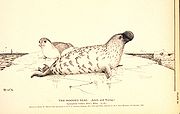 |
Hooded seals generally are found in the Atlantic Ocean, but occasionally individuals wander as far west as Alaska. | |
| Harbor seal Harbor Seal The harbor seal , also known as the common seal, is a true seal found along temperate and Arctic marine coastlines of the Northern Hemisphere... Phoca vitulina 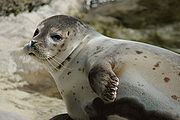 |
http://www.adfg.state.ak.us/pubs/notebook/marine/harseal.php |  |
| Harp seal Harp Seal The harp seal or saddleback seal is a species of earless seal native to the northernmost Atlantic Ocean and adjacent parts of the Arctic Ocean. It now belongs to the monotypic genus Pagophilus. Its scientific name, Pagophilus groenlandicus, means "ice-lover from Greenland", and its synonym, Phoca... Phoca groenlandica 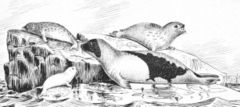 |
||
| Ribbon seal Ribbon Seal The ribbon seal is a medium-sized pinniped from the true seal family . A seasonally ice-bound species, it is found in the Arctic and Subarctic regions of the North Pacific Ocean, notably in the Bering Sea and Sea of Okhotsk. It is distinguished by its striking coloration, with two wide white... Phoca fasciata 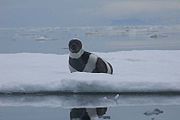 |
http://www.adfg.state.ak.us/pubs/notebook/marine/rib-seal.php |  |
| Ringed seal Ringed Seal The ringed seal , also known as the jar seal and as netsik or nattiq by the Inuit, is an earless seal inhabiting the Arctic and sub-Arctic regions... Phoca hispida  |
http://www.adfg.state.ak.us/pubs/notebook/marine/rin-seal.php | |
| Spotted seal Spotted Seal The spotted seal , also known as the larga or largha seal, is a member of the family Phocidae, and is considered a "true seal". It inhabits ice floes and waters of the north Pacific Ocean and adjacent seas... Phoca largha 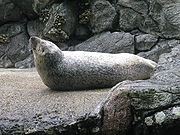 |
http://www.adfg.state.ak.us/pubs/notebook/marine/spt-seal.php |  |
| Northern fur seal Northern Fur Seal The Northern fur seal is an eared seal found along the north Pacific Ocean, the Bering Sea and the Sea of Okhotsk. It is the largest member of the fur seal subfamily and the only species in the genus Callorhinus.-Physical description:Northern fur seals have extreme sexual dimorphism, with males... Callorhinus ursinus 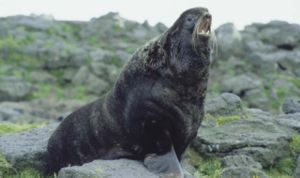 |
http://www.adfg.state.ak.us/pubs/notebook/marine/furseal.php |  |
| Steller's sea lion Steller's Sea Lion The Steller sea lion also known as the northern sea lion, is a threatened species of sea lion in the northern Pacific. It is the sole member of the genus Eumetopias and the largest of the eared seals . Among pinnipeds, it is inferior in size only to the walrus and the two elephant seals... Eumetopias jubatus 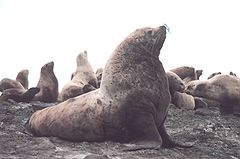 |
http://www.adfg.state.ak.us/pubs/notebook/marine/sealion.php |  |
| California sea lion California Sea Lion The California sea lion is a coastal sea lion of western North America. Their numbers are abundant , and the population continues to expand about 5% annually. They are quite intelligent and can adapt to man-made environments... Zalophus californianus 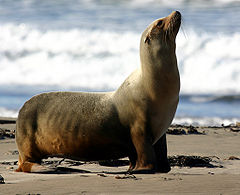 |
Between 1974 and 2004, 54 California sea lions were reported in Alaska. | |
| Walrus Walrus The walrus is a large flippered marine mammal with a discontinuous circumpolar distribution in the Arctic Ocean and sub-Arctic seas of the Northern Hemisphere. The walrus is the only living species in the Odobenidae family and Odobenus genus. It is subdivided into three subspecies: the Atlantic... Odobenus rosmarus 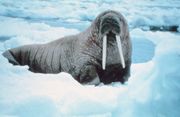 |
http://www.adfg.state.ak.us/pubs/notebook/marine/walrus.php |  |
Raccoons
| Species | More information |
|---|---|
| Raccoon Raccoon Procyon is a genus of nocturnal mammals, comprising three species commonly known as raccoons, in the family Procyonidae. The most familiar species, the common raccoon , is often known simply as "the" raccoon, as the two other raccoon species in the genus are native only to the tropics and are... Procyon lotor .jpg) |
The raccoon was introduced into Alaska in the 1930s for the fur trade. Very small but stable populations thrive in Southwestern parts of Alaska. |
Weasels and related animals (MustelidaeMustelidaeMustelidae , commonly referred to as the weasel family, are a family of carnivorous mammals. Mustelids are diverse and the largest family in the order Carnivora, at least partly because in the past it has been a catch-all category for many early or poorly differentiated taxa...
)
| Species | More information | Range |
|---|---|---|
| Wolverine Wolverine The wolverine, pronounced , Gulo gulo , also referred to as glutton, carcajou, skunk bear, or quickhatch, is the largest land-dwelling species of the family Mustelidae . It is a stocky and muscular carnivore, more closely resembling a small bear than other mustelids... Gulo gulo 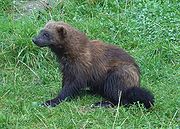 |
Wolverines are found primarily in the more remote areas of mainland Alaska and on some islands in Southeast Alaska. Because wolverines require large amounts of wilderness (the home range of a male may be up to 240 sq. mi.), they are sparsely distributed throughout their range. Wolverines are solitary, except during the May–August breeding season. Wolverines are better adapted for scavenging than for hunting and are opportunistic eaters. During winter, they primarily eat the carcasses of animals that have died of natural causes and the carcasses of moose and caribou left by wolves and hunters. The rest of the year their diet consists of smaller animals, such as voles, squirrels, snowshoe hares, and birds. On rare occasions, wolverines may kill moose or caribou.http://www.adfg.state.ak.us/pubs/notebook/furbear/wolverin.php | |
| Fisher Fisher (animal) The fisher is a medium-size mammal native to North America. It is a member of the mustelid family, commonly referred to as the weasel family. The fisher is closely related to but larger than the American Marten... Martes pennanti .jpg) |
||
| Marten American Marten The American marten is a North American member of the family Mustelidae, sometimes referred to as the pine marten. The name "pine marten" is derived from the common but distinct Eurasian species of Martes... 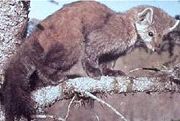 |
Marten are found from Southeast Alaska to the start of treeless tundra in Alaska's north and west. Marten are abundant in Alaska, being most common in the bogs and black spruce forests of Interior Alaska. In much of their range, especially in less optimal habitat, meadow voles and red-backed voles are marten's primary food source. Other important food sources include berries, small birds, eggs, plants, and carrion. Red squirrels, which are a major food source for martens in other areas, are not generally eaten by martens in Alaska. Marten are Alaska's most trapped animal, and as of 1994 generated $1–2 million in income in the state. In most areas, overtrapping is not a management problem.http://www.adfg.state.ak.us/pubs/notebook/furbear/marten.php | |
| Short-tailed weasel Ermine Ermine has several uses:* A common name for the stoat * The white fur and black tail end of this animal, which is historically worn by and associated with royalty and high officials... Mustela erminea  |
http://www.adfg.state.ak.us/pubs/notebook/furbear/weasels.php | |
| Least weasel Least Weasel The least weasel is the smallest member of the Mustelidae , native to Eurasia, North America and North Africa, though it has been introduced elsewhere. It is classed as Least Concern by the IUCN, due to its wide distribution and presumably large population... Mustela nivalis  |
http://www.adfg.state.ak.us/pubs/notebook/furbear/weasels.php | |
| Mink American Mink The American mink is a semi-aquatic species of Mustelid native to North America, though human intervention has expanded its range to many parts of Europe and South America. Because of this, it is classed as Least Concern by the IUCN. Since the extinction of the sea mink, the American mink is the... Mustela vison  |
Mink are found in every region of Alaska except Kodiak Island, the Aleutian Islands, Bering Sea offshore islands, and most of the North Slope. Mink are opportunistic hunters, eating almost anything that they can kill; important food sources include fish, birds, bird eggs, insects, crabs, clams, and small mammals. Wolves, foxes, hawks, owls, lynx, and river otters occasionally prey on mink, but the effects of predation on mink population have been studied relatively little. In Alaska, Mink are sometimes trapped for their fur.http://www.adfg.state.ak.us/pubs/notebook/furbear/mink.php | |
North American river otter |
River otters are found throughout Alaska except the Aleutian Islands, Bering Sea offshore islands, and the Arctic coast east of Point Lay. http://www.adfg.state.ak.us/pubs/notebook/furbear/rvrotter.php | |
| Sea otter Sea Otter The sea otter is a marine mammal native to the coasts of the northern and eastern North Pacific Ocean. Adult sea otters typically weigh between 14 and 45 kg , making them the heaviest members of the weasel family, but among the smallest marine mammals... Enhydra lutris 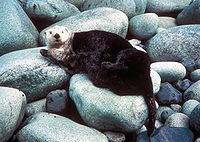 |
Early Russian settlement of Alaska can largely be credited to the sea otter industry; sea otter fur is perhaps the finest in the world. Sea otters were hunted nearly to extinction in the late 19th century. In 1911, when sea otters were so scarce that hunting was no longer profitable, they were protected under the international Fur Seal Treaty, and after further conservation measures the sea otter population increased from 2,000 to between 110,000 and 160,000 from 1911 to the mid-1970s. Today, most of the species' original habitat in Alaska has been repopulated, except for some areas of the Southeast. In Southeast Alaska, where sea otters were reintroduced in the 1960s,http://www.wavelengthmagazine.com/2005/jj05otter.php sea otters continue to expand.http://www.adfg.state.ak.us/pubs/notebook/marine/seaotter.php |  |
Ungulates
| Species | More information | Range |
|---|---|---|
| Elk Elk The Elk is the large deer, also called Cervus canadensis or wapiti, of North America and eastern Asia.Elk may also refer to:Other antlered mammals:... Cervus canadensis  |
Introduced, subspecies: Roosevelt Elk. Found in the southern tip of Alaska. |  |
| Moose Moose The moose or Eurasian elk is the largest extant species in the deer family. Moose are distinguished by the palmate antlers of the males; other members of the family have antlers with a dendritic configuration... Alces alces 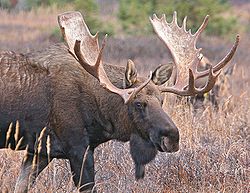 |
The Alaska subspecies Subspecies Subspecies in biological classification, is either a taxonomic rank subordinate to species, ora taxonomic unit in that rank . A subspecies cannot be recognized in isolation: a species will either be recognized as having no subspecies at all or two or more, never just one... of moose Moose The moose or Eurasian elk is the largest extant species in the deer family. Moose are distinguished by the palmate antlers of the males; other members of the family have antlers with a dendritic configuration... (Alces alces gigas) is the largest in the world; adult males weigh 1,200 to 1,600 pounds (542–725 kg), and adult females weigh 800 to 1,300 pounds (364–591 kg) Alaska's substantial moose population is controlled by predators such as bears and wolves, which prey mainly on vulnerable calves, as well as by hunters. Moose are often hunted for subsistence and recreation. More information... |
 |
| Sitka deer Sitka Deer The Sitka deer or Sitka black-tailed deer , is a subspecies of mule deer , and similar to another subspecies the black-tailed deer . Their name originates from Sitka, Alaska. Weighing in on average between , Sitka deer are characteristically smaller than other types of black-tailed deer... Odocoileus hemionus sitkensis 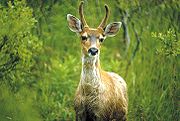 |
 |
|
| Caribou Rangifer tarandus  |
Alaska is home to the Rangifer tarandus granti subspecies Subspecies Subspecies in biological classification, is either a taxonomic rank subordinate to species, ora taxonomic unit in that rank . A subspecies cannot be recognized in isolation: a species will either be recognized as having no subspecies at all or two or more, never just one... of caribou. Caribou in Alaska generally are found in tundra Tundra In physical geography, tundra is a biome where the tree growth is hindered by low temperatures and short growing seasons. The term tundra comes through Russian тундра from the Kildin Sami word tūndâr "uplands," "treeless mountain tract." There are three types of tundra: Arctic tundra, alpine... and mountain regions, where there are few trees. However, many herds spend the winter months in the boreal forest areas. Caribou in Alaska are abundant; currently there are an estimated 950,000 in the state. The populations of caribou are controlled by predators and hunters (who shoot about 22,000 caribou a year). More information... |
 |
| Bison American Bison The American bison , also commonly known as the American buffalo, is a North American species of bison that once roamed the grasslands of North America in massive herds... Bison bison 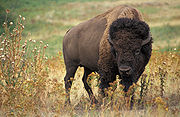 |
The ancestors of the American bison American Bison The American bison , also commonly known as the American buffalo, is a North American species of bison that once roamed the grasslands of North America in massive herds... (Bison bison bison) were introduced to Alaska in 1928. In 2003, there were approximately 900 wild American bison in Alaska. Their numbers are controlled by managed sport hunting, as predation is not common. Bison can occasionally be seen on their summer range from the Richardson Highway south of Delta Junction, on the Delta Junction Bison range and on the Delta Agricultural Project. Another sub-species of bison, the wood bison Wood Bison The Wood Bison, Bison bison athabascae, also called Mountain Bison, Wood Buffalo or Mountain Buffalo, is a distinct northern subspecies or ecotype of the American Bison... (b. b. athabascae) was once present in Alaska but is no longer. There are plans to reintroduce wood bison to Alaska in the near future. More information... |
 |
| Mountain goat Mountain goat The Mountain Goat , also known as the Rocky Mountain Goat, is a large-hoofed mammal found only in North America. Despite its vernacular name, it is not a member of Capra, the genus of true goats... 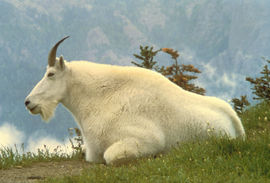 |
Mountain goats are found in the rough and rocky mountain regions of Alaska, throughout the Southeast and along the Coastal Mountains of the Cook Inlet Cook Inlet Cook Inlet stretches from the Gulf of Alaska to Anchorage in south-central Alaska. Cook Inlet branches into the Knik Arm and Turnagain Arm at its northern end, almost surrounding Anchorage.... . Populations are generally confined in the areas of the Chugach Chugach Chugach is the name of an Alaska Native culture and group of people in the region of the Kenai Peninsula and Prince William Sound. The Chugach people are an Alutiiq people who speak the Chugach dialect of the Alutiiq language.... and Wrangell Mountains Wrangell Mountains The Wrangell Mountains are a high mountain range of eastern Alaska in the United States. Much of the range is included in Wrangell-Saint Elias National Park and Preserve. The Wrangell Mountains are almost entirely volcanic in origin, and they include the second and third highest volcanoes in the... . Mountain goats have been transplanted to the islands of Baranof and Kodiak, where they have maintained a steady population. The mountain goat is the only representation in North America of the goat-like ungulates. Very little was known about mountain goats up until 1900. They constantly migrate to different areas from the alpine ridges in the summer, and to the tree-line in the winter. |
 |
| Dall sheep Dall Sheep The Dall sheep , Ovis dalli, is a species of sheep native to northwestern North America, ranging from white to slate brown in color and having curved yellowish brown horns... Ovis dalli 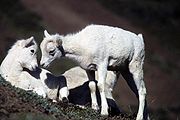 |
Dall sheep live in the mountain regions of Alaska where there is rocky terrain and steep, inclined land. The mountain setting is an ideal place for them to rest and feed. They are occasionally seen below their usual high elevation only when food is scarce. Alaska contains a good size population of Dall sheep. In their rocky environment, they are able to avoid predators and human activities. |  |
| Musk ox Musk Ox The muskox is an Arctic mammal of the family Bovidae, noted for its thick coat and for the strong odor emitted by males, from which its name derives. This musky odor is used to attract females during mating season... Ovibos moschatus 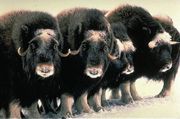 |
Re-introduced; spread from Alaska refugium after the Pleistocene Pleistocene The Pleistocene is the epoch from 2,588,000 to 11,700 years BP that spans the world's recent period of repeated glaciations. The name pleistocene is derived from the Greek and .... era, then died out in the state. |
 |
Cetaceans
| Species | More information | Range |
|---|---|---|
| Bowhead whale Bowhead Whale The bowhead whale is a baleen whale of the right whale family Balaenidae in suborder Mysticeti. A stocky dark-colored whale without a dorsal fin, it can grow to in length. This thick-bodied species can weigh to , second only to the blue whale, although the bowhead's maximum length is less than... Balaena mysticetus |
The Bering Sea Bering Sea The Bering Sea is a marginal sea of the Pacific Ocean. It comprises a deep water basin, which then rises through a narrow slope into the shallower water above the continental shelves.... stock of bowhead whales is the species' only population that exists in significant numbers, due to previous commercial whaling Whaling Whaling is the hunting of whales mainly for meat and oil. Its earliest forms date to at least 3000 BC. Various coastal communities have long histories of sustenance whaling and harvesting beached whales... . While there were 18,000 Bering Sea bowheads before the introduction of commercial whaling, their population was only between 6,400 and 9,200. Bering Sea bowheads follow a 3,600-mile (5800 km) migration route, wintering in the Bering Sea, then moving through the Bering Strait Bering Strait The Bering Strait , known to natives as Imakpik, is a sea strait between Cape Dezhnev, Chukotka Autonomous Okrug, Russia, the easternmost point of the Asian continent and Cape Prince of Wales, Alaska, USA, the westernmost point of the North American continent, with latitude of about 65°40'N,... , across the Chuckchi Sea, and into the Canadian Beaufort Sea Beaufort Sea The Beaufort Sea is a marginal sea of the Arctic Ocean, located north of the Northwest Territories, the Yukon, and Alaska, west of Canada's Arctic islands. The sea is named after hydrographer Sir Francis Beaufort... for the summer. To Alaskan Inuit Inuit The Inuit are a group of culturally similar indigenous peoples inhabiting the Arctic regions of Canada , Denmark , Russia and the United States . Inuit means “the people” in the Inuktitut language... , bowhead whales are the most important subsistence animal, both culturally and nutritionally. Subsistence whale hunts are managed in accordance with the International Whaling Commission International Whaling Commission The International Whaling Commission is an international body set up by the terms of the International Convention for the Regulation of Whaling , which was signed in Washington, D.C... ; 41 whales were taken in 1993. http://www.adfg.state.ak.us/pubs/notebook/marine/bowhead.php |
 |
 |
||
| North Pacific Right Whale North Pacific Right Whale The North Pacific right whale is a very large, robust baleen whale species that is now extremely rare and endangered. The Northeast Pacific subpopulation, that summers in the southeastern Bering Sea and Gulf of Alaska, may have no more than 50 animals... Eubalaena japonica |
 |
|
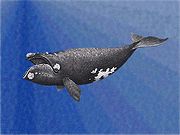 |
||
| Blue whale Blue Whale The blue whale is a marine mammal belonging to the suborder of baleen whales . At in length and or more in weight, it is the largest known animal to have ever existed.... Balaenoptera musculus |
Blue whales, which can be found in all the world's oceans, are rare north of the Bering Sea. Blue whales, which are migratory, may be seen in Alaska during the summer; historically, they have been sighted in the eastern Gulf of Alaska, the eastern Aleutians, and the far western Aleutians. Blue whales are rarely seen in near-shore Alaska waters, preferring to spend time along the edges of continental shelves. There have been few recent sightings of blue whales in Alaska; the total north Pacific population of blue whales was approximately 1,200 to 1,700 as of 1994, down from 4,900 to 6,000 before the advent of whaling. In the north Pacific, blue whales primarily eat the krill species Euphausia pacifica and Thysanoessa spinifera.http://www.adfg.state.ak.us/pubs/notebook/marine/blue.php |  |
 |
||
| Fin whale Fin Whale The fin whale , also called the finback whale, razorback, or common rorqual, is a marine mammal belonging to the suborder of baleen whales. It is the second longest whale and the sixth largest living animal after the blue whale, bowhead whale, and right whales, growing to nearly 27 metres long... Balaenoptera physalus |
 |
|
 |
||
| Sei whale Sei Whale The sei whale , Balaenoptera borealis, is a baleen whale, the third-largest rorqual after the blue whale and the fin whale. It inhabits most oceans and adjoining seas, and prefers deep offshore waters. It avoids polar and tropical waters and semi-enclosed bodies of water... Balaenoptera borealis |
 |
|
 |
||
| Minke whale Minke Whale Minke whale , or lesser rorqual, is a name given to two species of marine mammal belonging to a clade within the suborder of baleen whales. The minke whale was given its official designation by Lacepède in 1804, who described a dwarf form of Balænoptera acuto-rostrata... Balaenoptera acutorostrata |
 |
|
 |
||
| Humpback whale Humpback Whale The humpback whale is a species of baleen whale. One of the larger rorqual species, adults range in length from and weigh approximately . The humpback has a distinctive body shape, with unusually long pectoral fins and a knobbly head. It is an acrobatic animal, often breaching and slapping the... Megaptera novaeangliae |
Humpback whales are most commonly seen in Alaska during the summer; most of Alaska's humpbacks winter in Hawaii. While in Alaska, humpbacks frequent Southeast Alaska, Prince William Sound, the area near Kodiak and the Barren Islands, the area between the Semidi and Shumagin Islands, and the eastern Aleutian Islands and southern Bering Sea. Studies in the early 1990s showed that over 500 humpbacks summered in Southeast Alaska and over 100 summered in Prince William Sound. In Alaska, humpback whales' primary sources of food are herring, other small schooling fish, and krill; their primary predators are killer whales and humans.http://www.adfg.state.ak.us/pubs/notebook/marine/humpback.php |  |
 |
||
| Gray whale Gray Whale The gray whale, Eschrichtius robustus, is a baleen whale that migrates between feeding and breeding grounds yearly. It reaches a length of about , a weight of , and lives 50–70 years. The common name of the whale comes from the gray patches and white mottling on its dark skin. Gray whales were... Eschrichtius robustus |
http://www.adfg.state.ak.us/pubs/notebook/marine/gray.php |  |
 |
||
| Northern right-whale dolphin Northern Right Whale Dolphin The Northern right whale dolphin is a small and slender species of marine mammal found in the North Pacific Ocean. The Northern right whale dolphin travels in groups of up to 2000, often with other cetaceans, in deep waters of the North Pacific... Lissodelphis borealis |
||
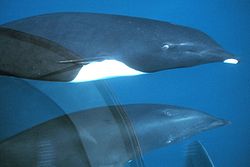 |
||
Lagenorhynchus obliquidens |
 |
|
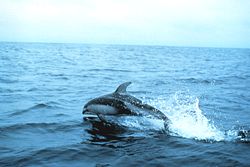 |
||
| Short-finned pilot whale Short-finned Pilot Whale The Short-finned Pilot Whale is one of the two species of cetacean in the genus Globicephala. It is part of the oceanic dolphin family , though its behaviour is closer to that of the larger whales.... Globicephala macrorhynchus |
 |
|
 |
||
| Risso's dolphin Risso's Dolphin Risso's dolphin is the only species of dolphin in the genus Grampus.-Taxonomy:Risso's dolphin is named after Antoine Risso, whose description formed the basis of the first public description of the animal, by Georges Cuvier, in 1812... Grampus griseus |
 |
|
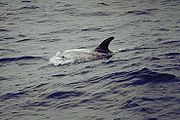 |
||
| Killer whale Orcinus orca |
The Killer whale is also known as the orca whale because it has been known to attack and eat other whales, and large prey animals such as seals Pinniped Pinnipeds or fin-footed mammals are a widely distributed and diverse group of semiaquatic marine mammals comprising the families Odobenidae , Otariidae , and Phocidae .-Overview: Pinnipeds are typically sleek-bodied and barrel-shaped... and sea lions. Orcas are scattered among the Continental Shelf Continental shelf The continental shelf is the extended perimeter of each continent and associated coastal plain. Much of the shelf was exposed during glacial periods, but is now submerged under relatively shallow seas and gulfs, and was similarly submerged during other interglacial periods. The continental margin,... from southeast Alaska through the Aleutian Islands. They can also be seen in the waters of Prince William Sound Prince William Sound Prince William Sound is a sound off the Gulf of Alaska on the south coast of the U.S. state of Alaska. It is located on the east side of the Kenai Peninsula. Its largest port is Valdez, at the southern terminus of the Trans-Alaska Pipeline System... . |
 |
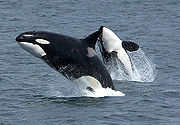 |
||
| Harbor porpoise Phocoena phocoena |
 |
|
.jpg) |
||
| Dall's porpoise Dall's Porpoise Dall's porpoise is a species of porpoise found on the North Pacific. It came to worldwide attention in the 1970s when it was disclosed for the first time to the public that salmon fishing trawls were killing a lot, thousands of Dall's porpoises and other cetaceans each year by accidentally... Phocoenoides dalli |
 |
|
 |
||
| Beluga whale Delphinapterus leucas |
During the summer, belugas eat a variety of fish, occasionally supplemented by other small marine life. Belugas' winter feeding habits are virtually unknown. Belugas are generally found in the ocean, but they may also ascend large rivers such as the Yukon on occasion and do not appear to be affected by the salinity change. There are two populations of belugas in Alaska. The Cook Inlet population is found in the inlet and Shelikof Strait region, and numbers approximately 400 to 500 animals. The larger Bering Sea population ranges throughout the Bering, Chukchi, and Beaufort seas; this group comprises perhaps 25,000 animals. Alaska natives harvest small numbers of belugas for food and oil.http://www.adfg.state.ak.us/pubs/notebook/marine/beluga.php |  |
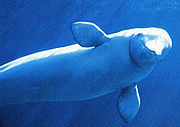 |
||
| Narwhal Narwhal The narwhal, Monodon monoceros, is a medium-sized toothed whale that lives year-round in the Arctic. One of two living species of whale in the Monodontidae family, along with the beluga whale, the narwhal males are distinguished by a characteristic long, straight, helical tusk extending from their... Monodon monoceros |
Occurs casually in Alaska waters. |  |
 |
||
| Sperm whale Sperm Whale The sperm whale, Physeter macrocephalus, is a marine mammal species, order Cetacea, a toothed whale having the largest brain of any animal. The name comes from the milky-white waxy substance, spermaceti, found in the animal's head. The sperm whale is the only living member of genus Physeter... Physeter macrocephalus |
 |
|
 |
||
| Cuvier's beaked whale Cuvier's Beaked Whale Cuvier's beaked whale is the most widely distributed of all the beaked whales. It is the only member of the genus Ziphius. Another common name for the species is goose-beaked whale because its head is said to be shaped like the beak of a goose. Georges Cuvier first described it in 1823 from part... Ziphius cavirostris |
 |
|
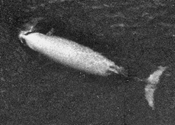 |
||
| Stejneger's beaked whale Stejneger's Beaked Whale Stejneger's beaked whale , sometimes known as the Bering Sea beaked whale or the Saber-toothed whale, is a poorly-known member of the genus Mesoplodon inhabiting the northern North Pacific Ocean. Leonhard Hess Stejneger initially described the species in 1885 from a skull, and nothing more of the... Mesoplodon stejnegeri |
||
 |
Primates
| Species | More information | Range |
|---|---|---|
| Human Human Humans are the only living species in the Homo genus... Homo sapiens 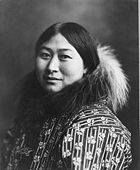 |
Humans began to inhabit Alaska at the end of the Upper Paleolithic Upper Paleolithic The Upper Paleolithic is the third and last subdivision of the Paleolithic or Old Stone Age as it is understood in Europe, Africa and Asia. Very broadly it dates to between 40,000 and 10,000 years ago, roughly coinciding with the appearance of behavioral modernity and before the advent of... Period (around 12,000 BCE), when Asiatic Asian people Asian people or Asiatic people is a term with multiple meanings that refers to people who descend from a portion of Asia's population.- Central Asia :... groups crossed the Bering Land Bridge Bering land bridge The Bering land bridge was a land bridge roughly 1,000 miles wide at its greatest extent, which joined present-day Alaska and eastern Siberia at various times during the Pleistocene ice ages. Like most of Siberia and all of Manchuria, Beringia was not glaciated because snowfall was extremely light... into what is now western Alaska. The state was populated by Alaska Native groups at the time Europeans first made contact with Alaska in 1741. A limited number of Russian colonists inhabited the state during the late 18th through the mid-19th century. Gold rushes in the late 19th century brought thousands of miners to Alaska, World War II expanded the state's infrastructure, and the 1960s discovery of oil attracted more residents. Presently, there are approximately 670,000 humans in Alaska, many of whom live in the state's few urban areas. According to the 2000 U.S. Census, 75% of Alaska residents are white. 19% are American Indian or Alaska Native, the largest proportion of any state. Multiracial/Mixed-Race people are the third largest group of people in the state, totaling 6.9% of the population. |
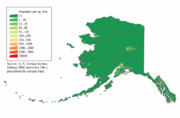 Human population density map |
Pikas, hares, and rabbits (LagomorphaLagomorphaThe lagomorphs are the members of the taxonomic order Lagomorpha, of which there are two living families, the Leporidae , and the Ochotonidae...
)
| Species | More information | Range |
|---|---|---|
| Collared pika Collared Pika The Collared Pika is small alpine lagomorph that lives in boulderfields of central and southern Alaska , and in parts of Canada, including northern British Columbia, Yukon, and western parts of the Northwest Territories. It is closely related to the American Pika... Ochotona collaris  |
 |
|
| Snowshoe hare Snowshoe Hare The Snowshoe Hare , also called the Varying Hare, or Snowshoe Rabbit, is a species of hare found in North America. It has the name "snowshoe" because of the large size of its hind feet and the marks its tail leaves. The animal's feet prevent it from sinking into the snow when it hops and walks... Lepus americanus 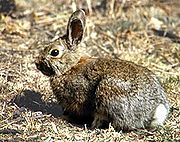 |
The snowshoe hare is the most common and widespread hare in Alaska, found everywhere in the state except the lower Kuskokwim Delta, the Alaska Peninsula, and the area north of the Brooks Range. They generally live in brush, mixed spruce forests, and wooded swamps. Snowshoe hare populations are dramatically cyclical, and in peak years there may be up to 600 snowshoe hares per square mi (230/km²) of the animals' range. The hares are a key food source for Alaska's furbearers, especially lynx, and are also important for human subsistence and recreational hunting. |  |
| Tundra hare Lepus othus  |
The tundra hare is most often found on the western coast of Alaska, including the Alaska Peninsula, and can occasionally be seen on the Arctic coast and the north slope of the Brooks Range. It generally lives on rocky slopes and upland tundra, avoiding lowlands and forests. They are important for subsistence and recreational hunting and for fur trapping. |  |
| European rabbit European Rabbit The European Rabbit or Common Rabbit is a species of rabbit native to south west Europe and north west Africa . It has been widely introduced elsewhere often with devastating effects on local biodiversity...  |
Introduced species, found in and around some urban and suburban locales.http://www.uaf.edu/ces/aiswg/pdf-documents/R10_Inv_Spp_Assessmt.pdf http://wildlife.alaska.gov/index.cfm?adfg=planning.anchoragec http://alaskamaritime.fws.gov/wildlife-wildlands/wildlife/nonnative/invasive-aleutians.htm http://links.jstor.org/sici?sici=0022-2372(196508)46%3A3<525%3ATROMIA>2.0.CO%3B2-1 |
RodentRodentRodentia is an order of mammals also known as rodents, characterised by two continuously growing incisors in the upper and lower jaws which must be kept short by gnawing....
s
| Name | Range | More information |
|---|---|---|
| Alaska marmot Alaska Marmot The Alaska Marmot , also known as the Brooks Range Marmot or the Browers , is a species of rodent in the family Sciuridae. It is found in the scree slopes of the Brooks Range, Alaska, which provide some protection from predators. They eat grass, flowering plants, berries, roots, moss, and lichen... Marmota broweri Image |
The Alaska marmot is found in the scree Scree Scree, also called talus, is a term given to an accumulation of broken rock fragments at the base of crags, mountain cliffs, or valley shoulders. Landforms associated with these materials are sometimes called scree slopes or talus piles... slopes of the Brooks Range, which provide protection from predators. They eat grass, flowering plants, berries, roots, moss, and lichen. Alaska marmots have special winter dens with a single entrance that is plugged during the entire winter hibernation period. They are built on exposed ridges that thaw earlier than other areas, and the entire colony stays within the den from September until the plug melts in early May. Most marmots mate before emerging from the winter den. In areas where marmots are hunted, marmots remain quiet when approached by humans; Alaska Natives have traditionally eaten marmot meat and used marmot fur in clothing.http://www.adfg.state.ak.us/pubs/notebook/furbear/marmot.php |
 |
| Hoary marmot Hoary Marmot The hoary marmot is a species of marmot that inhabits the mountains of northwest North America. Hoary marmots live near the tree line on slopes with grasses and forbs to eat and rocky areas for cover.... Marmota caligata  |
http://www.adfg.state.ak.us/pubs/notebook/furbear/marmot.php |  |
| Woodchuck Marmota monax 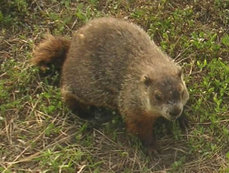 |
||
| Arctic ground squirrel Arctic Ground Squirrel The Arctic ground squirrel is a species of ground squirrel native to the Arctic.-Subspecies:Listed alphabetically.*S. p. ablusus Osgood, 1903... Spermophilus parryii  |
||
| Red squirrel American Red Squirrel The American Red Squirrel is one of three species of tree squirrel currently classified in the genus Tamiasciurus and known as pine squirrels... Tamiasciurus hudsonicus 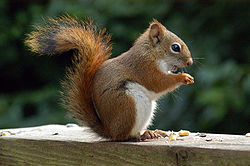 |
http://www.adfg.state.ak.us/pubs/notebook/furbear/redsquir.php | |
| Northern flying squirrel Northern Flying Squirrel The Northern flying squirrel is one of two species of the genus Glaucomys, the only flying squirrels found in North America . Unlike most members of their family, flying squirrels are strictly nocturnal... Glaucomys sabrinus 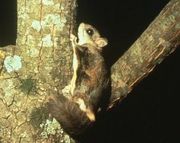 |
http://www.adfg.state.ak.us/pubs/notebook/furbear/nfsquirl.php | |
| Porcupine North American Porcupine The North American Porcupine , also known as Canadian Porcupine or Common Porcupine, is a large rodent in the New World porcupine family. The Beaver is the only rodent larger than the North American Porcupine found in North America... Erethizon dorsatum 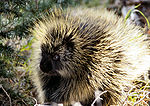 |
Weighing approximately 15 pounds, porcupines are the largest of Alaska's rodents except for beavers. Porcupines are found everywhere in Alaska except the Alaska Peninsula and Kodiak, Nunivak, and St. Lawrence islands. In winter, porcupines primarily eat trees' inner bark; in summer, they eat trees' buds and young leaves. Porcupines can cause forest management problems when they eat terminal buds or eating bark all the way around trees, though in most parts of Alaska there are not enough porcupines to cause significant damage. Though porcupine's quills discourage most predators, fishers, lynx, wolves, coyotes, and wolverines have developed methods of killing porcupines safely. Porcupines are also easily killed by hunters because of their plodding gate, but they are generally unpopular among hunters because of their meat's strong taste. Porcupine quills are used by Alaska Natives for decoration of clothing; these are collected by cornering porcupines and tapping them with a styrofoam paddle.http://www.adfg.state.ak.us/pubs/notebook/smgame/porky.php The porcupine didn't reached Alaska until the last ice age. | |
| Beaver American Beaver The North American Beaver is the only species of beaver in the Americas, native to North America and introduced to South America. In the United States and Canada, where no other species of beaver occurs, it is usually simply referred to as "beaver"... Castor canadensis 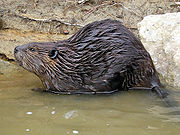 |
http://www.adfg.state.ak.us/pubs/notebook/furbear/beaver.php | |
| Bushy-tailed woodrat Bushy-tailed Woodrat The Bushy-tailed Woodrat, Packrat, or Woodrat is a species of rodent in the family Cricetidae.It is found in Canada and the United States.... Neotoma cinerea  |
||
| Deer mouse Peromyscus maniculatus Peromyscus maniculatus is a rodent native to North America. It is most commonly called the Deer Mouse, although that name is common to most species of Peromyscus and is fairly widespread across the continent, with the major exception being the southeast United States and the far north.Like other... Peromyscus maniculatus 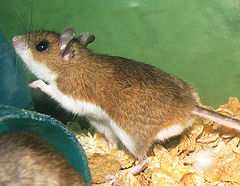 |
Introduced | |
| Forest deer mouse Peromyscus keeni Image |
||
| Meadow jumping mouse Meadow jumping mouse The meadow jumping mouse is the most widely distributed mouse in the subfamily Zapodinae. It may be found from the Atlantic coast, to the Great Plains, as far north as the arctic tree lines in Canada and Alaska, and as far south as Georgia, Alabama, Arizona, and New Mexico.- Description :The... Zapus hudsonius 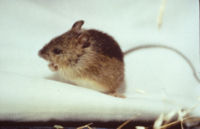 |
||
| Western jumping mouse Western Jumping Mouse The Western Jumping Mouse , is a species of rodent in the Dipodidae family. It is found in Canada and the United States.... Zapus princeps  |
||
| Norway rat Rattus norvegicus  |
Introduced. | |
| House mouse House mouse The house mouse is a small rodent, a mouse, one of the most numerous species of the genus Mus.As a wild animal the house mouse mainly lives associated with humans, causing damage to crops and stored food.... Mus musculus  |
Introduced. | |
| Brown lemming North American Brown Lemming The North American brown lemming, Lemmus trimucronatus, is a small North American lemming. Originally called the Siberian Brown Lemming Lemmus sibiricus it was later decided that they formed two distinct species.... Lemmus trimucronatus  |
http://www.adfg.state.ak.us/pubs/notebook/smgame/lemmings.php | |
| Northern collared lemming Northern Collared Lemming The Northern Collared Lemming , sometimes called the Peary Land Collared Lemming in Canada, is a small North American lemming. At one time, it was considered to be a subspecies of the Arctic Lemming... Dicrostonyx groenlandicus Image |
http://www.adfg.state.ak.us/pubs/notebook/smgame/lemmings.php |  |
| Northern bog lemming Northern Bog Lemming The Northern Bog Lemming, Synaptomys borealis is a small North American lemming. This is one of two species in genus Synaptomys, the other being the Southern Bog Lemming.... Synaptomys borealis Image |
http://www.adfg.state.ak.us/pubs/notebook/smgame/lemmings.php | |
| Long-tailed vole Long-tailed Vole The Long-tailed Vole is a small vole found in western North America. The Coronation Island Vole, once considered to be a separate species, is now believed to be a subspecies.... Microtus longicaudus  |
Long-tailed voles may be found throughout Southeast Alaska, the Yakutat forelands, and the far eastern Interior. | |
| Meadow vole Meadow Vole The Meadow Vole , sometimes called the Field Mouse or Meadow Mouse, is a North American vole found across Canada, Alaska and the northern United States. Its range extends further south along the Atlantic coast. One subspecies, the Florida Salt Marsh Vole , is found in Florida, and is classified as... Microtus pennsylvanicus 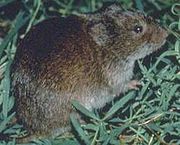 |
http://www.adfg.state.ak.us/pubs/notebook/smgame/voles.php | |
| Singing vole Singing Vole The singing vole, Microtus miurus, is a medium-sized vole found in northwestern North America, including Alaska and northwestern Canada.-Physical characteristics:... Microtus miurus 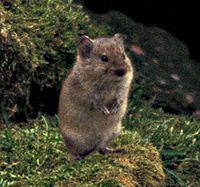 |
The distribution of the singing vole has not yet been well characterized. Specimens have been found on the North Slope, Seward Peninsula, Brooks Range, Alaska Range, south to the Kenai Peninsula and Cook Inlet, and west to Cape Newenham. There appear to be no singing voles in the Interior and Southeast. http://www.adfg.state.ak.us/pubs/notebook/smgame/voles.php |  |
| St. Matthew Island vole Microtus abbreviatus Image |
There have been relatively few observations of the St. Matthew Island vole, due to the inaccessibility of St. Matthew Island and the adjacent Hall Island, the only locations it has been found.http://www.uaf.edu/museum/mammal/AK_Mammals/Rodents/Microtus/abbreviatus/index.html On these Bering Sea Bering Sea The Bering Sea is a marginal sea of the Pacific Ocean. It comprises a deep water basin, which then rises through a narrow slope into the shallower water above the continental shelves.... islands, St. Matthew Island voles live in damp lowland areas, on the lower slopes of mountains, and on rye grass-covered beaches. They are diurnal and eat plant matter. Birds and Arctic foxes (the only other mammals on the island) prey on the voles.http://www.mnh.si.edu/mna/image_info.cfm?species_id=179 |
 |
| Tundra vole Tundra Vole The Tundra Vole or Root Vole, Microtus oeconomus, is a medium-sized vole found in Northern and Central Europe, Asia, and northwestern North America, including Alaska and northwestern Canada... Microtus oeconomus 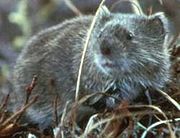 |
http://www.adfg.state.ak.us/pubs/notebook/smgame/voles.php | |
| Yellow-cheeked vole Microtus xanthognathus Image |
http://www.adfg.state.ak.us/pubs/notebook/smgame/voles.php | |
| Western heather vole Western Heather Vole The Western Heather Vole, Phenacomys intermedius, is a small vole found in western North America. Until recently, the Eastern Heather Vole, Phenacomys ungava, was considered to be a subspecies.... Phenacomys intermedius Image |
The first western heather vole specimen in Alaska was identified in 1999 near Hyder, Alaska Hyder, Alaska Hyder is a census-designated place in Prince of Wales-Hyder Census Area, Alaska, United States. At the 2000 census the population was 97. Hyder has achieved fame as a point in Alaska accessible to automobile and motorbike travelers in Canada who want to say that they have been to Alaska... . |
 |
| Northern red-backed vole Northern Red-backed Vole The northern red-backed vole, Myodes rutilus, is a small slender vole found in Alaska, northern Canada, Scandinavia and northern Russia.-Description:... Clethrionomys rutilus Image |
Northern red-backed voles are found throughout mainland Alaska. It is also found on Unimak Island and St. Lawrence Island, but not Southeast Alaska, Kodiak, or Nunivak Island. http://www.adfg.state.ak.us/pubs/notebook/smgame/voles.php |  |
| Southern red-backed vole Southern Red-backed Vole The Southern Red-backed Vole or Gapper's Red-backed Vole is a small slender vole found in Canada and the northern United States... Clethrionomys gapperi 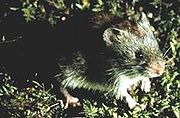 |
http://www.adfg.state.ak.us/pubs/notebook/smgame/voles.php |  |
| Muskrat Muskrat The muskrat , the only species in genus Ondatra, is a medium-sized semi-aquatic rodent native to North America, and introduced in parts of Europe, Asia, and South America. The muskrat is found in wetlands and is a very successful animal over a wide range of climates and habitats... Ondatra zibethicus  |
http://www.adfg.state.ak.us/pubs/notebook/furbear/muskrat.php |  |

